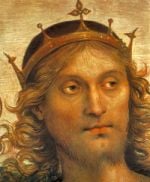Catholic Activity: Easter Eggs II
Decorate Easter eggs, symbols of hope and the resurrection.
DIRECTIONS
One of the easiest of Easter symbols to restore to Christian meaning is the egg. It is the symbol of hope and of resurrection, for Christ came forth from the tomb, just as the chick at birth breaks the shell. Traditionally, the eggs were marked with a cross, a banner of victory or the Chi-Rho (key-roe), the first two Greek letters of the word Christ. Eggs were stained brilliant red for the Passion, or gilded and signed Alleluia. Today's pale eggs with nonsensical symbols are a crying shame to Christians. To help families restore to the Easter egg its original symbolism we have included liturgical designs which are easy for children to copy. We leave some eggs white or brown. To decorate, we use pure vegetable food coloring full strength, available in food stores, and apply the colors with fine paint brushes or pens.
An egg tree can be made to display these eggs decorated with liturgical symbols. (A suitable branch put in water in a warm place will start to bud in a week. Use blown eggs and fasten to the branches by threading yarn through the holes in the eggs.)
Jubilee magazine, April 1955, carried an article on Ukrainian Easter Eggs, by Yaroslava Surmach who is one of the best artists in this field. The Ukrainian eggs, jewel-like masterpieces of exquisite workmanship, are for sale for those who wish to begin a collection. Designs used in the early Church, such as the fish, symbol of Christ, the rose, symbol of love, mark the eggs. Directions, dyes, beeswax, and the wax-writing instrument, called a kiska, used to decorate Pysanky or Easter eggs, may be procured from various Ukrainian resources. Families of Slavic extraction, art classes, and Scout groups will enjoy the work.
There is a charming Ukrainian folk tale that tells how Mary, carrying in her apron a gift of fresh eggs, appeared before Pilate to plead for her Son's life. When she heard Pilate's refusal of mercy, she fell to her knees in anguish. Her gift of eggs, spilling from her apron, rolled across the palace floor and out to the remotest corners of the world, as heralds of the coming Resurrection, bidding men to live by Christ's teachings of peace and love. Mary's tears, which had fallen upon the eggs, formed the brilliant dots of color and pattern.
EASTER: A circle or ring speaks of eternity in that it has no beginning and no end. It is the monogram of God, representing His perfection. Color: white.
ASCENSION: The crown stands for the victory of Christ. Color: gold.
PENTECOST: The dove is the symbol of the Holy Spirit. Its symbolism first appears in the baptism of Jesus. "I saw the spirit descending from heaven like a dove, and it abode upon Him" (John 1:32). Color: red.
TRINITY: The equilateral triangle represents the eternal, equal and indivisible Trinity. Three equal circles in triangle form are the monogram of the Father, Son and Holy Spirit. Color: white.
Activity Source: Family Customs: Easter to Pentecost by Helen McLoughlin, The Liturgical Press, Collegeville, Minnesota, 1956






